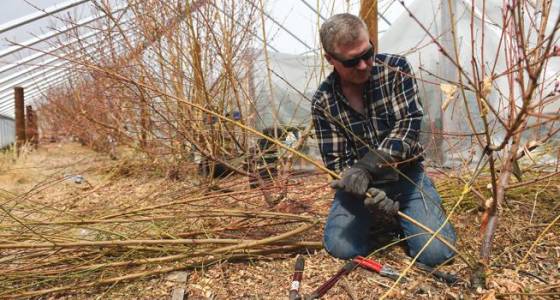If you've been itching to tidy up your fruit trees, February is an excellent time to get out and lop things. Pruning off a few branches is the perfect way to indulge our green thumbs in winter, plus keep our fruit trees healthy.
Let's take a look at the steps to follow when caring for trees that work for a living. To keep your trees in full production, spend time with them this spring by giving them a nip here, a tuck there, to tidy them up and get the flowers forming.
Pruning allows air and sunlight to reach the center of the tree, improving sugars in the fruit while reducing disease. For all types of fruit trees, follow a few basic steps:
Step 1: Tidy it up: Prune out any dead or diseased wood. Look for twigs that are dried out, with a grayish or black appearance. Although it's tempting to snap off dead wood, cut it off instead to avoid tearing the bark. Broken twigs are a harbor for disease, so cut them back to a bud or to the junction of twig to branch.
Step 2: One-way, please: Prune out any crossing or rubbing limbs. Branches that rub one another sloughs off bark, setting them up for disease problems. Crossing limbs, as they grow, often begin rubbing each other.
Step 3: Get rid of sprouts: Cut out water sprouts and basal suckers (the vigorous upright growth shooting up from branches or from the base of the tree). This type of growth is usually weak, and fruits poorly. Prune it completely off.
If you have peaches or nectarine trees here on the Front Range, you're a gardener who loves a challenge. Though these plants survive (well, they try to survive), they aren't the most productive fruit we can grow; frost freezes their buds off nine years out of ten. Nonetheless, we try to grow them, and to give them the best chance we can for forming fruit, it's all in the pruning.
Peaches and nectarines fruit on one-year old shoots, so the goal of pruning is to force part of the tree into new shoots every year. Do this by cutting back branches that fruited last year to a woody bud — it looks pointy instead of plump.
But don't go hog wild, cutting off every branch — only cut back one out of every four branches that fruited last year. This gives the tree enough leaves to photosynthesize food for itself. Do this every year, and your tree will give you plenty of fruit.
If you can't find woody buds on your shoots, don't worry. Very often these trees will have triple buds, where a woody bud is flanked by two flower buds. Prune off at this point, gently rub off the flower buds on either side, and let the woody bud grow into a shoot.
Important note: When pruning to a bud, prune one-quarter-inch above the bud, at a 45-degree angle. Pick buds that are pointing outward — they'll go that direction. Avoid inward-facing buds, since you don't want your branches to run back into the center of the tree.
If you're cutting the branch off entirely, prune to just outside of the raised area at the junction of the branch to the trunk — this is the branch collar. Leaving this intact will help the tree seal that cut off from disease.
Our editors found this article on this site using Google and regenerated it for our readers.












